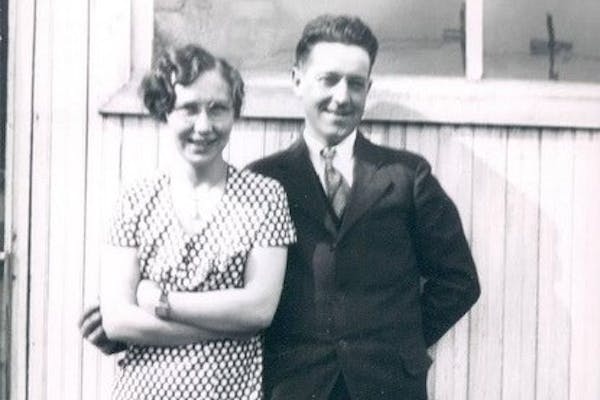As a teenager in the 1940s, Tom Groebner delivered the morning mail in his southern Minnesota hometown of New Ulm.
"All the regular mail carriers were in the service, fighting in World War II," said Groebner, 96. "So the post office hired us high school kids during the summer."
Eight decades later, Groebner recalled a postcard tucked in his mail bag — a memory that provided a living link to U.S. Army Capt. Willibald (Bill) Bianchi, killed in action by friendly fire in 1945.
Before Bianchi was captured by the Japanese and held for nearly three years as a prisoner of war in the Philippines, he won the Medal of Honor for combat bravery in 1943. He's the only soldier from Brown County to receive the military's highest honor, and one of 72 fellow Minnesota honorees spanning from the Civil War to Vietnam.
Groebner only wishes Carrie Bianchi would have been home when he delivered her son's postcard from his prison camp in the Philippines. She was probably preparing pastries at her bakery job in New Ulm that morning.
"I would have liked to see her reaction, because at least she knew he was alive," Groebner said.
That good news was short lived. Bianchi was among 270 prisoners killed on Jan. 9, 1945, when U.S. bombers destroyed an unmarked ship anchored off Taiwan that they didn't know was transporting American prisoners from the Philippines to Japan. Bianchi had survived a friendly-fire bombing only three weeks before, but not this time. He was 29.
Ten months later, Carrie Bianchi received a letter from Gen. Douglas MacArthur, who assured her that the courage of her son and his fellow soldiers had "stopped the enemy in the Philippines," enshrining their names "in our country's glory forever." MacArthur concluded: "In your son's death I have lost a gallant comrade and mourn with you."
Born in 1915, Bill Bianchi (pronounced Bee-AN-chee) grew up on a 73-acre poultry farm south of New Ulm. His father, Joseph, died accidentally when his shotgun discharged into his chest while chasing away a stray dog. Bill, then 17, had gone to tell his father he had a phone call when he found the body.
As the lone son with four sisters, Bill left high school to tend to the farm but eventually continued his education in animal science at the University of Minnesota and South Dakota State College (now University) in Brookings, where he was active in ROTC. He was commissioned a second lieutenant in the Army when he graduated from South Dakota State in 1940.
Eight months before Japan attacked Pearl Harbor, Bianchi was part of an early mission to train Filipino soldiers to resist Japanese aggression. During the Battle of Bataan in early 1942, shortly after the U.S. joined the war, Bianchi was tossing grenades into a Japanese machine-gun nest when two bullets passed through his left hand and another two entered his chest. Despite his wounds, he climbed atop a tank and kept firing at the enemy until an explosion blew him off the tank. His valor earned him the Medal of Honor.
He wasn't done yet. Two months after returning to battle, he was among 75,000 soldiers captured when Bataan fell to the Japanese in April 1942. Starving and thirsty, Bianchi walked 65 miles to a prison camp as part of the notorious Bataan Death March. He would remain a prisoner — at one point supervising a burial detail — until his death nearly three years later.
Unmarried with no children, Bianchi's legacy lives on thanks to his nieces and nephews, who've donated his Medal of Honor and other awards to the Brown County Historical Society in New Ulm. Sue Marti has a storage bin filed with letters about her uncle, including one from Brig. Gen. Ted Spaulding who detailed how Bianchi showed "great character and determination" in distributing meager food rations to his fellow prisoners.
"Mom always talked about what a kind and gentle man Uncle Bill was," said Marti, 69, who lives in New Ulm.
Carrie Bianchi accepted her son's Medal of Honor at a Fort Snelling ceremony in 1946. "I am proud to be able to give this generation and our beloved America the most precious gift that life makes possible, my only son," she wrote in a New Ulm newspaper. Her only regret, she said, was that she "didn't have four more sons to give to this country."
In 1955, the city of New Ulm bestowed the name Bianchi Drive on a hilltop road about a mile southwest of where Bill had lived with his mother. His name is listed at the Punchbowl, the national cemetery in Honolulu, but he's believed to be buried in a mass grave in Taiwan. Family members have contributed DNA samples to help in efforts to locate his remains.
Curt Brown's tales about Minnesota's history appear every other Sunday. Readers can send him ideas and suggestions at mnhistory@startribune.com. His latest book looks at 1918 Minnesota, when flu, war and fires converged: strib.mn/MN1918.

Civil War group honors the last Union veteran buried in each Minnesota county

St. Cloud professor's book paints nuanced look at enslaved woman freed in Minneapolis

Paying overdue tribute to his grandmother, a Minnesota farmer recarves family history

Civil War officer brought formerly enslaved family to Minnesota





